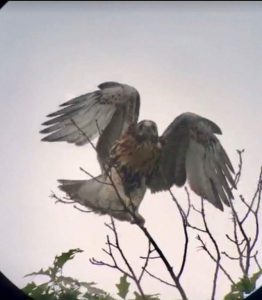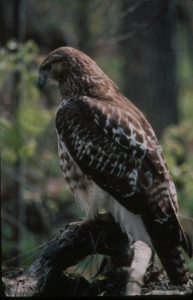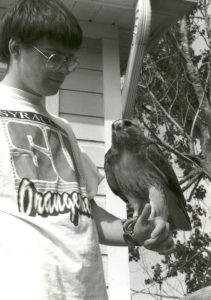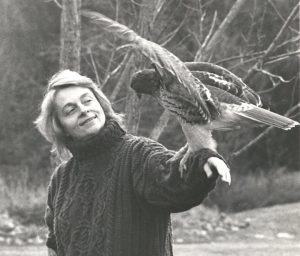Wonderful
 Recently, in an effort to dodge all my Facebook wannabe suitors I decided to replace my portrait there with a representative image. Rummaging through 20 years of my own pictures, I was arrested by this blurry, long-ago snapshot of Merak, the human-imprinted red-tailed hawk, who flew free at Foley Mountain, but saw me and my family as her own.
Recently, in an effort to dodge all my Facebook wannabe suitors I decided to replace my portrait there with a representative image. Rummaging through 20 years of my own pictures, I was arrested by this blurry, long-ago snapshot of Merak, the human-imprinted red-tailed hawk, who flew free at Foley Mountain, but saw me and my family as her own.
Two clicks and success. My Facebook/Instagram portrait changed from human to hawk. It amuses me that I do find this shot of Merak rummaging around for twigs to refurbish her large, messy nest is a more representative shot of me than the portrait was.
Every time I see pictures of this beloved, if damaged, bird I remember the 17 years of my complex, magical relationship with her and I feel a surge of wonder. It was just this time of year that this half-wild red-tailed hawk came to us at the Conservation Area. The baby raptor had been confiscated by the Ministry of Natural Resources from a teenager who was hoping to train her for falconry. (It is illegal to keep a wild creature in captivity in Ontario.) She had overwintered under supervision of the late Kit Chubb of the Avian Care and Research Foundation, and now it was Kit’s hope that in releasing Merak to the relative safety of the 800 acres of the Foley Mountain Conservation Area, she would rewild.
On that cold, bright and breezy day, Barry wheelbarrowed the large box containing the hawk to the middle of the fields and tore open the flaps, opening our world to this very large bird. For a least 10 minutes she stood staring with her far-seeing eyes before she hopped neatly out of her box and flew with slow beats to a distant pine. Here she perched for at least an hour before disappearing into the woods. “It may well be that you will never see her again,” said Kitt, over-optimistically, as it turned out.
I’ve told the magical story of how Merak learned to be wild, and how we learned to live with her, in my book A Wing in the Door and many times since to interviewers and audiences. I chose this name for my story because not only did the hawk literally try to shoulder her way into our house, but also because living with her gave us a precious opening into her own world.
 But this came after months of uncertainty about how a very immature hawk was going to learn to live with us and to live in the wild. At first, at Kit’s advice, Barry built a feeding platform in the field back of our home, and every day he called her there and offered her lab mice from Kit’s store. From the start, he and the bird established a rapport, but when I had to take a turn making the long, vulnerable walk across the open field to give Merak her mice I had no way of knowing whether the unpredictable young female would accept me as a substitute for Barry. That day I proceeded warily, hoping against hope to reach the feeding platform before Merak noticed me. Unfortunately, as I wrote in A Wing in the Door, all too quickly I was assaulted by the infantile bird’s hungry screams, and I saw her lunging, rather than flying, toward me. Until this horrifying moment, when I came face-to-face with them, I had not appreciated just what devastatingly effective weapons her rapier talons were.
But this came after months of uncertainty about how a very immature hawk was going to learn to live with us and to live in the wild. At first, at Kit’s advice, Barry built a feeding platform in the field back of our home, and every day he called her there and offered her lab mice from Kit’s store. From the start, he and the bird established a rapport, but when I had to take a turn making the long, vulnerable walk across the open field to give Merak her mice I had no way of knowing whether the unpredictable young female would accept me as a substitute for Barry. That day I proceeded warily, hoping against hope to reach the feeding platform before Merak noticed me. Unfortunately, as I wrote in A Wing in the Door, all too quickly I was assaulted by the infantile bird’s hungry screams, and I saw her lunging, rather than flying, toward me. Until this horrifying moment, when I came face-to-face with them, I had not appreciated just what devastatingly effective weapons her rapier talons were.
Worst of all, in past encounters the hawk had shown herself to be wildly temperamental and unpredictable. Should I drop to the ground, covering my face? At the last heart-stopping moment, she veered aside and struck out for the platform, where she made a heavy landing. She screamed lustily as I approached, and the screams escalated as, with a shaking hand, I pitched the soggy gray mouse bodies onto the platform in front of her. Pinning them with her talons, she pivoted so that her back was to me, flared her tail, and shrouded the platform with her magnificent outspread wings.
 Eventually, it turned out that the person she loved most was our younger son, Jeremy. Even once he had gone away to university, she somehow knew when he was coming home. She might have been away hunting for weeks during fair autumn weather, but as soon as Jeremy stepped out of the car she sailed in to greet him with special talk which she reserved just for him. (Lately I was telling a new friend about her special affinity with our son, and she pointed out to me that she must have bonded with the young falconer who had snatched her from her nest. Perhaps Jeremy most resembled her first human friend.)
Eventually, it turned out that the person she loved most was our younger son, Jeremy. Even once he had gone away to university, she somehow knew when he was coming home. She might have been away hunting for weeks during fair autumn weather, but as soon as Jeremy stepped out of the car she sailed in to greet him with special talk which she reserved just for him. (Lately I was telling a new friend about her special affinity with our son, and she pointed out to me that she must have bonded with the young falconer who had snatched her from her nest. Perhaps Jeremy most resembled her first human friend.)
My own favorite memory of this special hawk is of experiencing her learning to soar. I would see her pin-prick small in the sky and then would watch her slowly, slowly descend to my outstretched wrist, talking and talking to me about the wonders of flight. She came purely because she chose to, giving herself freely to me and my family.
I want to end my reminiscence with this passage from my book, where I wrote of Merak, truly free at last:
I go from miracle to miracle this autumn. A storm is approaching: the air is hot, heavy, and ominous. I walk to the beach, a half hour from our house, and sit watching the waves come in. A gale is blowing up. On the waves there is the glitter of a wan, evil sun. Over my head hovers a large, shadowy bird, magnificently in control of the battling wind. I watch in amazement how able it is to defy the wind with only the slightest tilt of its wings. Merak in this distant place? But so proficient is this bird, and so sure of this foreign territory of ridge and lake, that I doubt the silhouette could be hers. It disappears; it returns; it cuts the wind superbly. It is deftness in the teeth of the approaching storm, giving an exhilarating sense of a creature married to the elements. At last, as if the raging air had become breathless, the bird fans its tail, drops its feet, and sinks precisely onto the top of the wobbly, rotten flagpole, becoming Merak. In her hovering repeatedly directly over my head, she been present to me, and I have the impression that she wanted me to know how very able she is and how delighting in this other new home of hers.
It occurs to me that in this drifting autumn weather, Merak, no longer our hawk, is drifting too, in the state between ending and becoming, flying between the realms of death and birth. In limbo, she floats between the secure world near our house, and the world where she is a windhover, breasting a gale over lake and ridge. As she moves toward final and complete independence, she is existing in a pocket of other time. Each time I see her, it is a last time. Each time is more of a miracle than the last.
Having such an intimate relationship with a hawk for seventeen years changed my life forever. After she disappeared the night of a violent May thunderstorm Barry and I searched everywhere for her, calling and calling for weeks, but the sky never answered. We wept together knowing that we would never know the end of this story. And I have never stopped missing her.
For a long while after Merak disappeared, I would glance at passing red-tails on poles, “I know you. You are kin to me.” Only, in return, all I that I received was an understandably hostile stare. That door is closed to me forever. Now, each spring as the hawks return to sail with the thermals of the valley here, I am stirred again. Currently these are a pair of wide-ranging red-shouldered ones and also two feisty sharp-shinned ones. I never stop feeling joy in seeing them, but I will never again have that special relationship of crossing the natural boundaries between human and hawk.
- To read more about Merak and our experience with her: perimcquay.ca/wing-in-the-door/
- (The first and second editions are now out of print.)
A wonderful gift to hawk lovers is the Cornell webcam following the mated pair of hawks on the campus there. This can be followed on Twitter (X) but also on You Tube and Facebook
